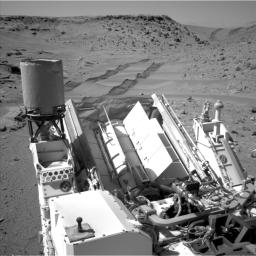
|
Curiosity Making Headway West of ‘Dingo Gap’
- Click the image above for a larger view
- Full-Res JPEG (1024 x 1024) (165.9 kB)
- Full-Res TIFF (1024 x 1024) (1.1 MB)
Caption:
NASA's Curiosity Mars rover used the Navigation Camera (Navcam) on its mast to catch this look-back eastward at wheel tracks from driving through and past "Dingo Gap" inside Gale Crater. The gap, spanned by a 3-foot-tall (1-meter-tall) dune, is at the right-hand side of the horizon in this scene. Curiosity crossed the dune on the 535th Martian day, or sol, of the rover's work on Mars (Feb. 6). On Sol 538 (Feb. 9), it drove 135 feet (41.1 meters) farther westward. This image was taken on Sol 539 (Feb. 10) from the location reached by the previous sol's drive. For scale, the distance between the parallel wheel tracks is about 9 feet (2.7 meters).
The high-mounted cylinder on the rear part of the vehicle is the rover's UHF (ultrahigh frequency) antenna. The set of disks mounted below it is part of the calibration target for Curiosity's Chemistry and Camera (ChemCam) instrument. The ball-on-a-stick device in the foreground is the calibration target, including a sundial, for Curiosity's Mast Camera (Mastcam). To the right of the UHF antenna in this image are the radiator fins for Curiosity's power supply, a radioisotope thermoelectric generator.
Background Info:
NASA's Jet Propulsion Laboratory, Pasadena, Calif., manages the Mars Science Laboratory Project and the mission's Curiosity rover for NASA's Science Mission Directorate in Washington. The rover was designed and assembled at JPL, a division of the California Institute of Technology in Pasadena.
More information about Curiosity is online at http://www.nasa.gov/msl and http://mars.jpl.nasa.gov/msl/ .
Cataloging Keywords:
| Name | Value | Additional Values |
|---|---|---|
| Target | Mars | |
| System | ||
| Target Type | Planet | |
| Mission | Mars Science Laboratory (MSL) | |
| Instrument Host | Curiosity Rover | |
| Host Type | Rover | |
| Instrument | Hazard Camera (Hazcam) | |
| Detector | ||
| Extra Keywords | Crater, Dune, Grayscale | |
| Acquisition Date | ||
| Release Date | 2014-02-11 | |
| Date in Caption | ||
| Image Credit | NASA/JPL-Caltech | |
| Source | photojournal.jpl.nasa.gov/catalog/PIA17939 | |
| Identifier | PIA17939 | |
